|
FAQs about Non-Vertebrate Animal Identification
52
Related Articles: Marine Invertebrates, Marine Invertebrate Systems, Marine Invertebrate Compatibility,
Marine Invertebrate Disease,
Marine Invertebrate
Reproduction, Quarantine of Corals and
Invertebrates, Feeding
Reef Invertebrates, Lighting
Marine Invertebrates, Water Flow, How Much
is Enough,
Related FAQs: Non-Vert IDs 1, Non-Vert IDs 2, Non-Vert IDs 3, Non-Vert IDs 4, Non-Vert IDs 5, Non-Vert IDs 6, Non-Vert IDs 7, Non-Vert IDs 8, Non-Vert IDs 9, Non-Vert IDs 10, Non-Vert IDs 11, Non-Vert IDs 12, Non-Vert IDs 13, Non-Vert IDs 14, Non-Vert IDs 15, Non-Vert IDs 16, Non-Vert IDs 17, Non-Vert IDs 18, Non-Vert. ID 19, Non-Vert. ID 20, Non-Vert. ID 21, Non-Vert. ID 22, Non-Vert. ID 23, Non-Vert. ID 24, Non-Vert. ID 25, Non-Vert ID 26, Non-Vert ID 27, Non-Vert ID 28, Non-Vert ID 29, Non-Vert ID 30, Non-Vert ID 31, Non-Vert ID 32, Non-Vert 33, Non-Vert ID 34 Non-Vert ID 35, Non-Vert ID 36, Non-Vert ID 37, Non-Vert ID 38, Non-Vert ID 39, Non-Vert ID 40, Non-Vert ID 41, Non-Vert ID 42, Non-Vert ID 43, Non-Vert ID 44, Non-Vert ID 45, Non-Vert ID 46, Non-Vert ID 47, Non-Vert ID 48, Non-Vert ID 49, Non-Vert ID 50, Non-Vert ID 51, Non-Vert ID 52, Non-Vert ID 53, Non-Vert ID 54, Non-Vert ID 55, Non-Vert ID 56,
Non-Vert ID
57, Non-Vert ID 58,
Non-Vert ID 59,
Non-Vert ID 60, Non-Vert ID 61,
& Marine Invertebrates, Marine Invert.s 2, Marine Invert.s 3, & FAQs about:
Marine Invertebrate Behavior,
Marine Invertebrate
Compatibility, Marine
Invertebrate Selection, Marine
Invertebrate Systems, Feeding
Reef Invertebrates, Marine
Invertebrate Disease, Marine
Invertebrate Reproduction, &
LR Life
Identification, LR Hitchhiker ID
1, Anemone Identification,
Aiptasia
Identification, Aiptasia ID 2,
Worm Identification, Tubeworm ID, Polychaete Identification, Snail Identification, Marine Crab
Identification, Marine Invert.s 1,
Marine Invert.s 2, Marine Plankton,
|
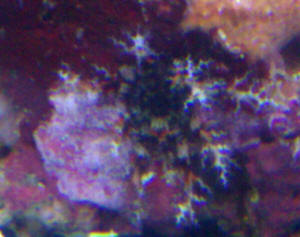
|
|
What is This? Harmless Acoel Flatworms --
5/23/10
Crew,
<Hello, Lynn here this evening.>
My son saw these crawling on the glass like little inch worms.
The bulb end expands and stretches out and the two little tails
follow. There were 5 or 6 between 1/16" and 1/4"
long.
<No worries, they're harmless little Acoel flatworms. They
tend to pop up, stick around for a bit, then disappear. For more
information, please see the following links: http://www.wetwebmedia.com/flatworms.htm
http://www.wetwebmedia.com/flatwrmfaq3.htm
>
Thanks
<You're most welcome. Take care, Lynn Z>
|
 |
|
Weird Sea Creature 4/25/10
Hi Guys and Gals,
I have a couple of creatures that I'm trying to identify.
I've looked at a lot of pics and I can't seem to find
these. I think they are an anemone but they seem to be part of a
dark green mossy patch. They have a cone like center mouth area
and clear tentacles with little white bubble tips. Each one is
about 1/3 of an inch in diameter. I have one patch with about 3
or 4 of them and one single one. I have attached a picture, they
are not that bright in color but I had to use a flash, in normal
light they are pretty dull in color. Anybody know what they are?
Do I need to remove them? They don't look like the AIPTASIA I
had before.
<These are likely Hydropolyps...: http://wetwebmedia.com/hyzoanidfaq.htm
and the linked files/FAQs above re Compatibility. Most likely
I'd ignore as being of little deleterious consequence>
Tank 75 Gallon, purchased 5 months ago used had been set up for
about a year. We kept most of the original substrate and
water.
Has a small 5 gallon sump and a 10 gallon refugium with some live
rock and Chaetomorpha.
Temp 78
Ammonia 0
Nitrites 0
Nitrates usually 5 currently 20 temporary skimmer malfunction.
Creatures were they before incident.
PH 8.3
Calcium 480
Usually do small weekly water changes and add some Iodide and
Strontium/Magnesium.
CORALS:
BROWN MUSHROOMS,GREEN STRIPED MUSHROOM,COLT CORAL, YELLOW
TOADSTOOL
LEATHER, SUN CORAL, GREEN AND ORANGE POLYP, SEVERAL RICORDEA, AND
A STAR
BURST POLYP.
FISH:
2 CLOWNS, 1 SPOT FOX FACED RABBIT, RED MANDARIN GOBY, 1 CLEANER
SHRIMP, 1
BLOOD RED FIRE SHRIMP, ASSORTED HERMITS AND SNAILS.
<Man! That's bold!>
We had a cleaner shrimp and a Coral beauty completely vanish and
have yet to figure out what happened to them. We thought mantis
on a new piece of rock but haven't caught anything in our
trap.
Thanks for any help!
Jim
<The other little curlicues are likely Serpulid worms... even
more innocuous. Bob Fenner>
|
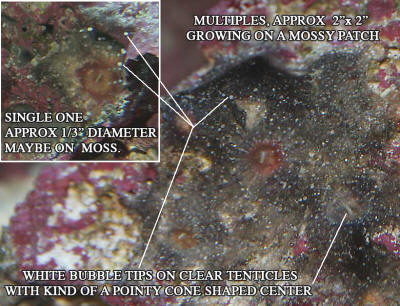 |
re: Weird Sea Creature
4/26/10
Hi Guys
Thanks for the quick response it helped a lot. I did have a
question about
one comment, after our coral and livestock(> CORALS:BROWN
MUSHROOMS,GREEN
STRIPED MUSHROOM,COLT CORAL, YELLOW TOADSTOOL LEATHER, SUN CORAL,
GREEN AND ORANGE POLYP, SEVERAL RICORDEA, AND A STAR BURST
POLYP.
FISH: 2 CLOWNS, 1 SPOT FOX FACED RABBIT, RED MANDARIN GOBY, 1
CLEANER SHRIMP, 1 BLOOD RED FIRE SHRIMP, ASSORTED HERMITS AND
SNAILS.) Mr. Fenner said <Man! That's bold!>. Is there a
possible issue or something amiss that we need to be on the lookout
for?
Thanks again for your quick help. Jim Humble
<... read where you were referred to... and DO NOT write to us
in all cap.s. Your email will summarily be deleted. B> |
|
White Cottony Specks 4/24/10
Hello, and HELP !!!,
I have seen an outbreak of something I am not sure if I can
identify. I see little white specks (about 1/16 inch at most) all
over my live rock. I have been getting a few Aiptasia, and have
been using a liquid control
substance. I am concerned that this is a massive outbreak, but
these are different. Magnified, they look like Aiptasia, but are
different. They have a tiny thread-like stalk, and the tendrils
are like strands of cotton. I am having trouble magnifying to
take a pic, so here are my best pics. I have ordered Berghia
Nudibranchs
<Mmm, not helpful>
in the hopes that I will be a step ahead. I have also seen pics
that are upside down jellyfish polyps that look like this. Any
idea what these are? How to deal with them?
Thanks, SCOTT
<Likely Hydrozoans. Read here: http://wetwebmedia.com/hyzoancompfaq.htm
and the linked files above. Bob Fenner>
|
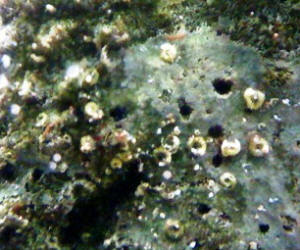 |
Re: White Cottony Specks
4/24/10
Thanks Bob,
Any recommendations?
<? Read where you were referred to. B>
It is completely covering my live rock, and I have seen no effects
on my corals. I am mostly concerned with looking out for my
seahorses and pipefish. The pipefish are fry, so I am having to
feed them daily hatched brine. I think this is the cause of this
massive outbreak, too much nutrient in the water. It seems to have
broken out following the birth. |
|
Funky Tube-ish... Thing - 4/19/10
Hey Crew!
I have been using your site to answer many many questions
I've had on my salt water aquarium. My main question at the
moment I have been trying to research for a couple weeks and have
come up with no answers, so I'm hoping you might be able to
help me. On my first purchase of live rock, which I've had
for about a month now, I have
been noticing all sorts of fun and sometimes freaky things
springing up here and there (some literally!) The one I am most
curious about is a tube that is attached sideways towards the
bottom of the rock. It is a dark brownish color that has an
almost marbleized coloring to it with black and a lighter beige
coloring. At each end of the tube there is an opening that is
rimmed white. Both ends open and close
<Mmmm?>
if there is a shadow cast, a funny noise, or a snail climbing
over the top of it. What are the possibilities of what this weird
looking creature could be?
<Maybe two tube-dwelling/tubiculous Sedentariate Polychaete
worms:
http://wetwebmedia.com/feathwmidf3.htm
and the linked files above, or Vermetid snails:
http://wetwebmedia.com/MolluscPIX/Gastropods/Prosobranch%20PIX/Vermetids/tubesnailidf.htm
I actually have two of them within an inch of each other on this
rock. Thank you very much for your help!
Manda
<Photos are useful. Bob Fenner>
Re: Funky Tube-ish... Thing 4/19/10
Thank you for the very quick reply. I could not find anything
coming even close to resembling what this is in the links you
provided. I have inserted the best picture I could with as few
kilobytes as I could, so I apologize for the quality of the
photo. If you look at the bottom left of the picture, there is a
white ring with some dark behind it. That is the specimen in
question facing in one direction.
(You can't see the other end from this view) If you look at
the upper right of the picture, there are two white circles with
a darker section attaching them in the middle. That is the
specimen from the side view. Both have the "mouths"
open hence the white. If they were closed, you would see no
white. There are no legs, and they don't move from the spot
they are in, but they are growing. (the one on the bottom was
about the size of the one up top when first noticed, and the one
on the top didn't exist.)
Thank you again for your help!
Manda
<... This looks like a tunicate: http://www.wetwebmedia.com/ascidians.htm
B>
|
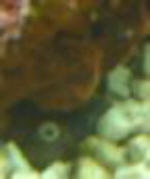 |
|
Sea Grape 4/17/10
Hi Bob, Lynn,
<Neale>
I wonder if you know what this object is. A friend found several
of them on a beach in Florida. As you can see, they're about
the size of a penny. They are grainy like rough paper, slightly
glossy, and with a hole at one end.
They look a bit like the cells of burrowing wasps to me, but I
don't think that's the case of they were found on a
beach. Any ideas?
Cheers, Neale
<Mmm, my best guess w/ these pix, descriptions is that these
are Foraminiferan skeletons. Lynn? BobF>
Re: Sea Grape 4/17/10
Thank you Bob. I'd considered that idea too, e.g., Gromia
spp., but thought these specimens were perhaps rather too large
for inshore Forams.
Cheers, Neale
<Might/could have been transported from deeper water... air
filled w/ decomposition of other life that had come to reside
w/in. BobF>
|
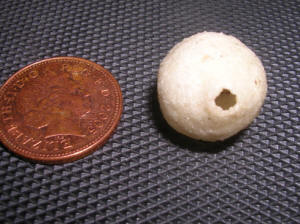 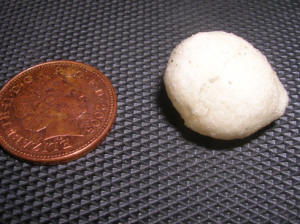 |
|
Sea Grape, Lynn's go 4/17/2010
<Hi Bob, Neale>
I wonder if you know what this object is. A friend found several
of them on a beach in Florida. As you can see, they're about
the size of a penny. They are grainy like rough paper, slightly
glossy, and with a hole at one end. They look a bit like the
cells of burrowing wasps to me, but I don't think that's
the case of they were found on a beach. Any ideas?
<The first thing it reminded me of was a praying mantis egg
case:
http://2.bp.blogspot.com/_lDfVXMCBuu0/STthPwvtTkI/AAAAAAAACBA/NPcU2zgD-fg/s1600-h/praying+mantis+egg+sacs.jpg
or a wasp gall, but it could be something like a bleached Prickly
Palm nut (Acrocomia spp.). They vary in size, can range in color
from black to bleached white and have a rough texture (before
polishing). There's a whole group of people that collect all
sorts of "sea beans" on beaches. I have a few myself,
but have never seen anything like this. Here are a few examples
(some have been polished):
Prickly Palm nuts spread across upper left area (note the white
one):
http://1.bp.blogspot.com/_uuHPvedMUw4/SwiON_fvX_I/AAAAAAAACzM/WyFhO88s5hA/s1600/IMG_0209.jpg
Here's a before/after (polishing) of a Prickly Palm nut:
http://1.bp.blogspot.com/_uuHPvedMUw4/SRdJ9iTRl9I/AAAAAAAABhY/0n49DBITJ70/s1600-h/IMG_0239.jpg
If I had to guess, I'd say it's a Prickly Palm nut. If
not, my next guess would be some sort of deserted, combination
mucus/sand burrow, or subsurface egg chamber made by what I
don't know, that was exposed at some point. I don't
remember the sand in Florida being that white but it's been a
while since I was there. Hope that helps! Take care, Lynn>
Cheers, Neale
Hello Lynn,
The sea grape doesn't have the three-fold radial symmetry of
the palm nut, and is far too thin and light anyway, so I
don't think that's right. But your idea of some sort of
hardened burrow makes sense. Dried mucous would give the
glossiness I'm seeing, and it could easily be stuck together
from sand. What sorts of animals lay eggs in subsurface
burrows?
Cheers, Neale
|
|
Creepy worm...help! 4/10/10
Hello crew,
Thanks again for the help with the wrasse last week. He has now
gotten used to his new home and comes out on occasion to eat,
mostly in the morning. I now need your help again.
I recently bought 2 pieces of live rock from my LFS. One they
were selling as "aqua cultured" and it was in a tank
with just live rock and had coral lighting on it with tons of
coralline algae of dark maroon and purple, and even orange (if it
is even possible to have orange algae). Well anyway, I bought
them home and put them in my tank. I was not too worried about
culturing the other piece since it was a fairly new set up and I
only had the wrasse and a percula clown in there. I kept noticing
what looked like a small sea cucumber that was black with spikes
in one of the holes in the rock, but it never moved so I
didn't think that's what it was. But just a few minutes
ago, I noticed about 6 arms that each looked like a tree with
small white branches and red arms sticking out of the hole. The
animal would routinely pull a branch into the hole, which
apparently is its mouth, to eat what the arm caught from the
water. I know this is probably just another harmless live rock
hitch hiker, but it looks really kind of scary when you look at
it close, and I am really curious as to what it is and what I
should feed it. I have attached a few pictures I snapped of it
with my phone...they are the best I could get since it is sort of
a small hole. You can see in the pictures the arm structures and
the hole they are coming from. They kind of blend in with the
algae on the rock, but the little white crack looking thing is
the arms. Also, if you have the time, can you tell me if the
coral that is in the third & fourth picture is hard or soft
coral and maybe a species? It looks as though the body structure
is a hard coral but it also sort of looks like the head of a star
polyp with small white dots on the tips. Thanks for all your
help!
Eric
<The first is a sea cucumber of some sort, for the
Scleractinian, peruse the families on WWM. Bob Fenner>
|
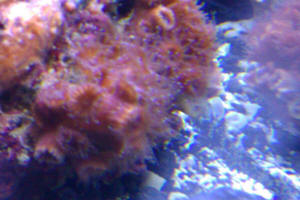  |
|
|

